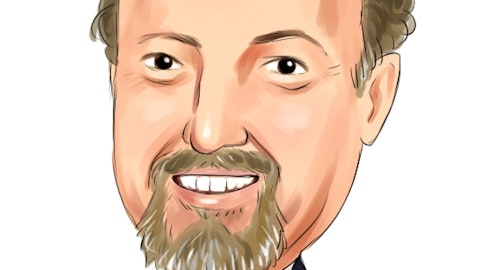Whatever shows up next year, we did 12 months ago. So I think in general, our ability to look forward and see the business allows us to really invest in craft long-term, in our people long-term. And we’re doing that, we’re hiring people for the future now. We’re skating where the puck is going. I like it. And so I think we have no issues in craft at this point being able to hire, train, maintain. We just got to do it at the production levels we expect.
Operator: Our next question comes from the line of Chad Dillard with Bernstein.
Chad Dillard : So Duke, you were talking about how utilities are shifting CapEx from distribution to transmission. Just trying to get a better sense for how that impacts Quanta’s business. I think you have talked about better market share on transmission, but any sense on just like how to think about it from a margin standpoint, from a utilization standpoint? And then secondly, based on your conversations with utilities, is the case like some of the work that was pushed out to ’24, is that actually expect on the ’25 because we’ll be a little bit more able to change your CapEx plan a little bit further out?
Duke Austin : Yes. I mean, I think we’ve heard most of our customers. I’ll go backwards on that. Most of our customers maintain their capital guides and some increase. I still — you got a backdrop of anything we’re saying. You can look at the capital spend and what the customer is saying. I think honestly, you’ll start to see them raise capital again, owe around it. I think capital is going up, not down over the next — whenever they talk about their next five years, you can see capital plans go up, has to, to meet the demand. And so we’re talking about getting more usage out of the grid. Even if you get more use out grid, capital is going up. So I do think there’s some things you can do from technology, but it’s incidental compared to what you see from the demand side.
So both of those things are going to happen. As far as distribution, I think it’s just we kind of — it’s status quo, which we expected more growth out of it. And not all customers, I want to be clear on this, not all customers are going down on distribution. Some in the southeast, a few here or there, do shift capital over into transmission. So in some areas, that’s the case. Some areas, distributions the same are moving up. You got storm hardening, you got fire hardening, you got a hundred different things also going on. And the everyday grid depreciates every given day. Poles rot, things — it’s always been that way and that’s still ongoing with everything else that’s going on. So the maintenance of the grid stays in place. And so that — but the capital is required to maintain the capital required to necessary infrastructure electric vehicles.
I mean, I think the pause and — somewhat pause and delay a bit in the electric vehicle penetration, although it’s going to trade nicely, it’s certainly something that we’re watching. And I think that — we’ve always said that would be a three, four decade-type penetration versus overnight. I mean it was not going to happen by 2030. We thought 2050, 2040. I mean, I think that’s the case. And the distribution just a longer build but it’s much, much bigger even in transmission, just longer. And so I like them both. It’s going to show up over time. I mean just because a company time — it’s technical. It gives the company time to rethink about those resources and how do we resource these things as they come about.
Chad Dillard : And I want to go back to the two comments you made. So earlier in the Q&A, you talked about it seems to have a really strong uptick on the data center side in January through March. And then you just talked about what you do today began 12 months ago. So just trying to think through like when we start seeing a lot of the work tied to data centers, just to kind of work through a tonic provide us with like an expected cadence on that.
Duke Austin : I mean, I think we see a lot of plans today on large-scale, hyperscale basis. And that loads got to go to them. And that planning process, we do a lot of system planning. And that system planning process is probably robust today as it’s ever been on the transmission load side of the business. We’ve got to get the distribution business a little better. And we’ve got to talk to the regulators and talk to them about what we’re seeing and making sure that the consumer is not paying for the data on demand. So I think that’s the bigger thing, the affordability. Natural gas is down and it just kind of flat, so it’s softening the consumer at the bill level. And so that’s a good thing. If natural gas stays down and we get some interest kind of where it’s at or even less, it bodes well.
And I think you’ll see the capital plans and everyone get their head around. I’m looking at the calls as well. I mean everyone’s got equity plans now. And if we didn’t see that show up until this quarter, where you’re starting to see people issue equity and that against builds that are coming. It’s necessary, and we start to see that show up. And I think the business — you can see where the planning is coming into place and how quickly things move against equity and data at the utility level. So we see a lot. We’re excited about it. And I do believe it’s not just something that you can’t go, we’re going to build this. And they’re going to not pay for it. I think this is real. I do. I think the demand is real. Even if it’s half what everyone is saying, it’s more than we’re talking about now.
So that’s the bet of it. You hedge it down and it’s still huge. So I like it. And I think we’re sitting in a really good spot here, and we’re starting to see those investments show up. It will be like we see today, a little better. But the 24-month planning cycle is ongoing and utilities today are planning for the future. So I think every single quarter, you’ll see the progression and it stacks. And we always thought that these bigger programs, these bigger things would stack on the business long term, and your base would continue to move up kind of double-digits, and that’s what we see.
Operator: [Operator Instructions] Our next question will come from the line of Brett Castelli with Morningstar.
Brett Castelli : I just wanted to ask within renewables. Can you parse out your expectations for new orders between wind and solar for the full year by ’24, any thoughts relative to 2023 between the technologies there?
Duke Austin : I mean I would just say, like, we’ve talked about growing double-digits and we’re growing double digits plus EV and wind and solar as well beyond that. But obviously, we’re comfortable with double-digit growth in those businesses.
Operator: Our next question comes from the line of Abhi Jaroslavich with UBS.
Unidentified Analyst: I’m [Steve Fisher]. So recently, we’ve seen some more federal support coming out for permitting but also some lower capital intensity type of opportunities within transmission. Just how are you guys thinking about which is going to be the bigger driver for that over the next one to two years? And also, what kind of visibility to bookings you have within those transmission projects?
Duke Austin : I want to make sure I understand the question, and it’s a little spotty on my side here. As far as permitting, I mean, I think state permitting in general is fine. It’s more about the regulatory process is a permit, in my mind. I don’t think I caught the rest of the question. Did you hear it?
Jayshree Desai : He was asking about the innovation around.
Unidentified Analyst: Yes, I was just asking like.
Duke Austin : We’ve seen some innovation — sorry about that. Yes. My apologies. We’ve seen some innovation throughout the year. I think you’ll continue to see it. There’s things going on. But it’s incidental really. I mean it’s good, it will help, but the demand is such that we’ll continue to see that. We always go back and look at Europe and what’s going on there, a lot of innovation in Europe. It’s 3x a quarter of what we have here. And the cheapest form of moving generation is transmission. You still need — still the cheapest form today and it will be tomorrow and the next day. So I do think that builds in the multiyear builds are there. You have to balance the load, so you’re seeing some equipment come in, [inaudible] things like that, that are coming into the business that allows some balance.
You’re starting to see that go up from an equipment standpoint. We’ll install it. There’s software out there that’s helping some on a distribution level, transmission level. But it’s — I still think even with innovation, we got a long way to go on infrastructure.
Operator: Our next question comes from the line of Kevin Gainey with Thompson Davis & Company.
Kevin Gainey : I just wanted to maybe touch on the equity income at electric power in the guidance range there. How should we think about that? What’s driving that? And then, maybe the cadence as we go throughout the year?
Jayshree Desai : Yes. The increase there was primarily driven by our Puerto Rican entity, our JV Helima. There was a favorable tax ruling that allowed for us to be able to — the tax rate has dropped significantly. And so you’re seeing around a $6 million improvement over the year as a result of that ruling.
Operator: And our next question comes from the line of Jean Ramirez with D.A. Davidson.
Jean Ramirez : This is Jean for Brent Thielman. I wanted to ask a question about the underground gas utility portion of the segment. Are you guys seeing any utilities pull back on at all on network investments and reliability upgrades?
Duke Austin : No. I think to the contrary, the investments necessary there and methane releases things of that nature. When you start looking at natural gas systems, they’re more valuable today because we’re not building as much new system. I mean there’s a considerable amount of new systems being built, but in certain areas where you’re replacing caster other lines with polyethylene and more, you’re building a modern network. That’s certainly there and will continue to be there. We see an uptick in the business, not a downtick.
Operator: We have reached the end of our question-and-answer session. I would now like to turn the floor back over to management for any closing comments.
Duke Austin : Yes. I want to think 52,800 people out in the field that pay our paychecks and do what they do today in inclement weather. We can’t say enough about their performance and the safety and the things that they do on a daily basis. Our field leadership is the best in the world. The management team that we have here is certainly something that we’re extremely proud of where the company is going, and thank you for participating in the call today.
Operator: This concludes today’s teleconference. You may disconnect your lines at this time. Thank you for your participation.
Follow Quanta Services Inc. (NYSE:PWR)
Follow Quanta Services Inc. (NYSE:PWR)
Receive real-time insider trading and news alerts




